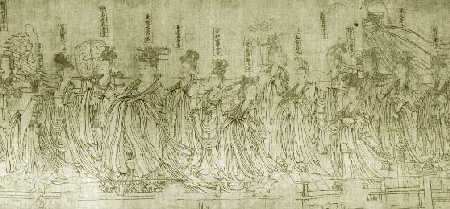Imperial painting academies were first established in the Five Dynasties. They were under the direct administration of the imperial government. Painters of the academies enjoyed the same treatment as literary officials in courts, wore official suits, and received salaries from the imperial government. The academies gathered the most excellent painters in the country. Their tasks were to draw portraits for the nobles, and when important social events occurred, they were required to record them in paintings. These activities helped to improve the skills of the painters. Well-known painters during this period include the flower and bird painters, Huang Quan and Huang Jucai of the Shu State (908-925) and the portrait painters Cao Zhongxuan, Zhou Wenju and Gu Hong of the Southern Tang State (947-958). They were responsible for great artistic achievements and strongly influenced their successors.

By Wu Zongyuan, Song Dynasty
The Song Dynasty united China again in 960 and expanded the imperial painting academy. All the great painters from the Five Dynasties applied for posts in the Song Dynasty Imperial Painting Academy, and it became the creative center of painting of the time. The abbot of the Zhaoying Palace of the YuqingTempleselected painters to draw murals on the palace wall; over 3,000 painters came for the selection examination and about 100 were chosen, including Wu Zongyuan, whose works were considered as good asWu Daozi's. Zhang Zeduan, painter of theQingming Festival by the Riverside, also served in the Imperial Painting Academy.
The Imperial Painting Academy reached its peak of development in the period from Emperor Huizong's reign to Emperor Xiaozong's reign of theSouthern Song Dynasty(1127-1279). The entry examination for the painting academy was included in the imperial civil service examination system.
The painting examination contained six subjects, including drawing pictures based on ancient poems. Some painters chose unique angles to reveal the meaning of the poems. For example, in drawing the concept for the line "No body comes across the wild river, A single boat stays on the river", one painter portrayed a boatman asleep at one end of the boat with a flute beside him, indicating he had had no customers the whole day and felt very tired. In another examination, for the line "An ancient temple hides in the deep mountain", a painter drew a young monk fetching water from a stream.
